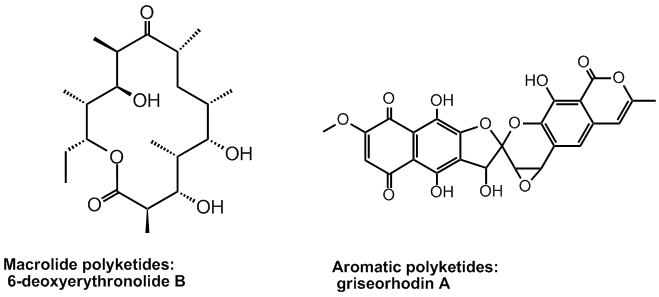Lipid Classification System
Lipid Definition
A lipid is generally considered to be any molecule that is insoluble in water and soluble in organic solvents. Biological lipids usually refer to a broad grouping of naturally occurring molecules which includes fatty acids, waxes, eicosanoids, monoglycerides, diglycerides, triglycerides, phospholipids, sphingolipids, sterols, terpenes, prenols, fat-soluble vitamins (such as vitamins A, D, E and K) and others [1,2,3], in contrast to the other major groupings of biological molecules, namely the nucleic acids, amino acids, and carbohydrates (sugars). The main biological functions of lipids include their central role in energy storage, as structural components of cell membranes, and as important signaling molecules.Lipids may be broadly defined as hydrophobic or amphipathic small molecules that originate entirely or in part by carbanion-based condensations of thioesters and/or by carbocation-based condensations of isoprene units [4].

Using this approach, lipids have been divided into eight categories: fatty acyls, glycerolipids, glycerophospholipids, sphingolipids, saccharolipids and polyketides (derived from condensation of ketoacyl subunits); and sterol lipids and prenol lipids (derived from condensation of isoprene subunits)[4,5].
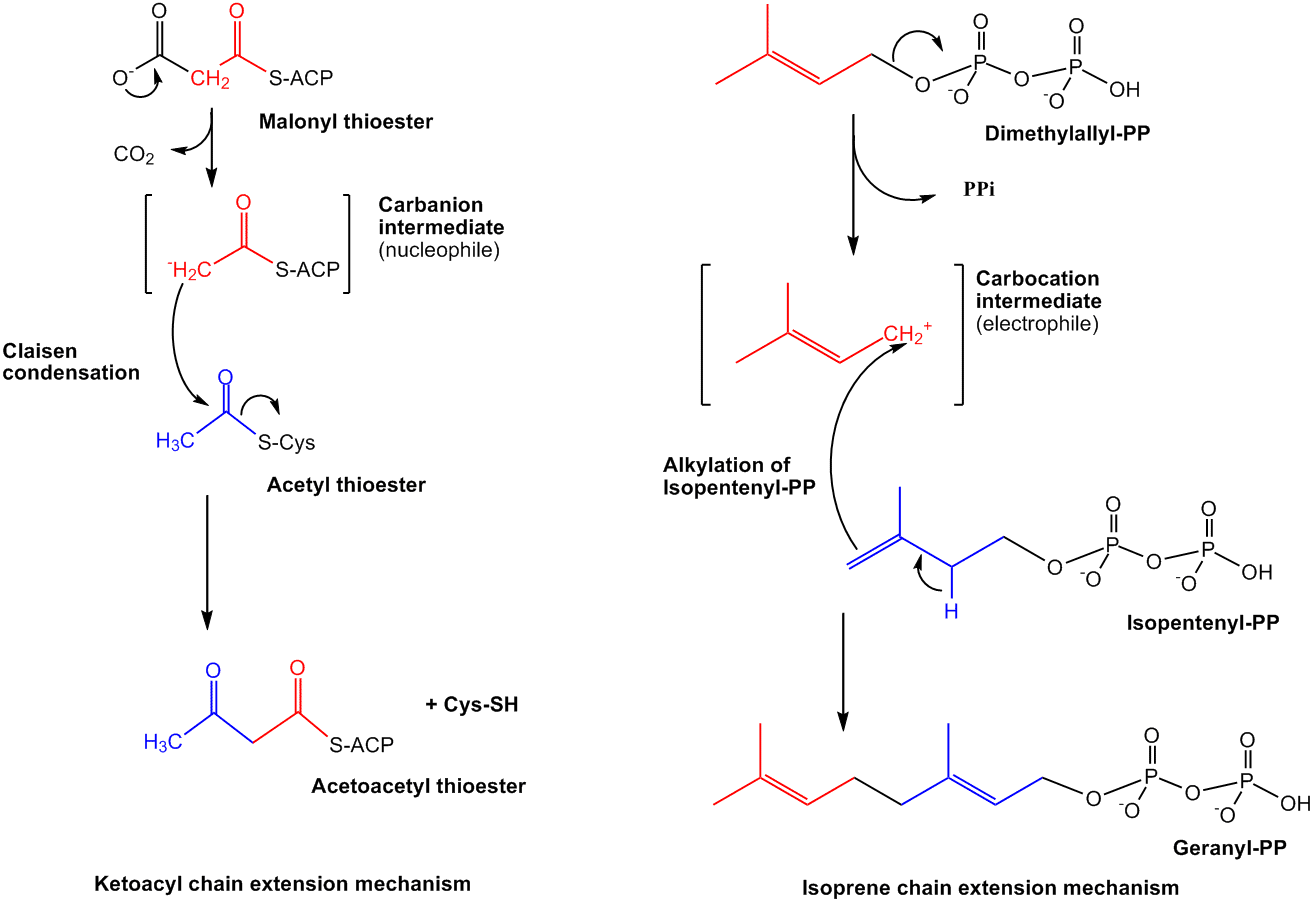
See examples of structures for the 8 lipid categories.
Categories of Lipids
Fatty acyls [FA]
The fatty acyls [FA] are a diverse group of molecules synthesized by chain elongation of an acetyl-CoA primer with malonyl-CoA (or methylmalonyl-CoA) groups that may contain a cyclic functionality and/or are substituted with heteroatoms. The fatty acyl structure represents the major lipid building block of complex lipids and therefore is one of the most fundamental categories of biological lipids. The fatty acyl group in the fatty acids and conjugates class is characterized by a repeating series of methylene groups that impart hydrophobic character to this category of lipids. The first subclass includes the straight-chain saturated fatty acids containing a terminal carboxylic acid. It could also be considered the most reduced end product of the polyketide pathway. Variants of this structure have one or more methyl substituents and encompass quite complex branched-chain fatty acids, such as the mycolic acids. The longest chain in branched-chain fatty acids defines the chain length of these compounds. A considerable number of variations on this basic structure occur in all kingdoms of life, including fatty acids with one or more double bonds and even acetylenic (triple) bonds. Heteroatoms of oxygen, halogen, nitrogen, and sulfur are also linked to the carbon chains in specific subclasses. Cyclic fatty acids containing three to six carbon atoms as well as heterocyclic rings containing oxygen or nitrogen are found in nature. The cyclopentenyl fatty acids are an example of this latter subclass. The thia fatty acid subclass contains sulfur atom(s) in the fatty acid structure and is exemplified by lipoic acid and biotin. Thiols and thioethers are in this class, but the thioesters are placed in the ester class because of the involvement of these and similar esters in fatty acid metabolism and synthesis. Separate classes for more complex fatty acids with multiple functional groups (but nonbranched) are designated by the total number of carbon atoms found in the critical biosynthetic precursor. These include octadecanoids and lipids in the jasmonic acid pathway of plant hormone biosynthesis, even though jasmonic acids have lost some of their carbon atoms from the biochemical precursor, 12-oxo-phytodienoic acid. Eicosanoids derived from arachidonic acid include prostaglandins, leukotrienes, and other structural derivatives. The docosanoids contain 22 carbon atoms and derive from a common precursor, docosahexaenoic acid. Many members of these separate subclasses of more complex fatty acids have distinct biological activities.
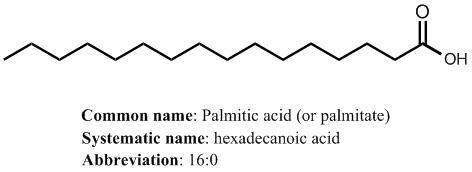
Other major lipid classes in the fatty acyl category include fatty acid esters such as wax monoesters and diesters and the lactones. The fatty ester class also has subclasses that include important biochemical intermediates such as fatty acyl thioester-CoA derivatives, fatty acyl thioester-acyl carrier protein (ACP) derivatives, fatty acyl carnitines (esters of carnitine), and fatty adenylates, which are mixed anhydrides. The fatty alcohols and fatty aldehydes are typified by terminal hydroxy and oxo groups, respectively. The fatty amides are also N-fatty acylated amines and unsubstituted amides, and many simple amides have interesting biological activities in various organisms.The fatty amides include N-acyl ethanolamines such as anandamide. Fatty acyl homoserine lactones are fatty amides involved in bacterial quorum sensing Hydrocarbons are included as a class of fatty acid derivatives because they correspond to six electron reduction products of fatty acids that may have been generated by loss of the carboxylic acid from a fatty acid or fatty acyl moiety during the process of diagenesis in geological samples. Long-chain ethers also have been observed in nature.
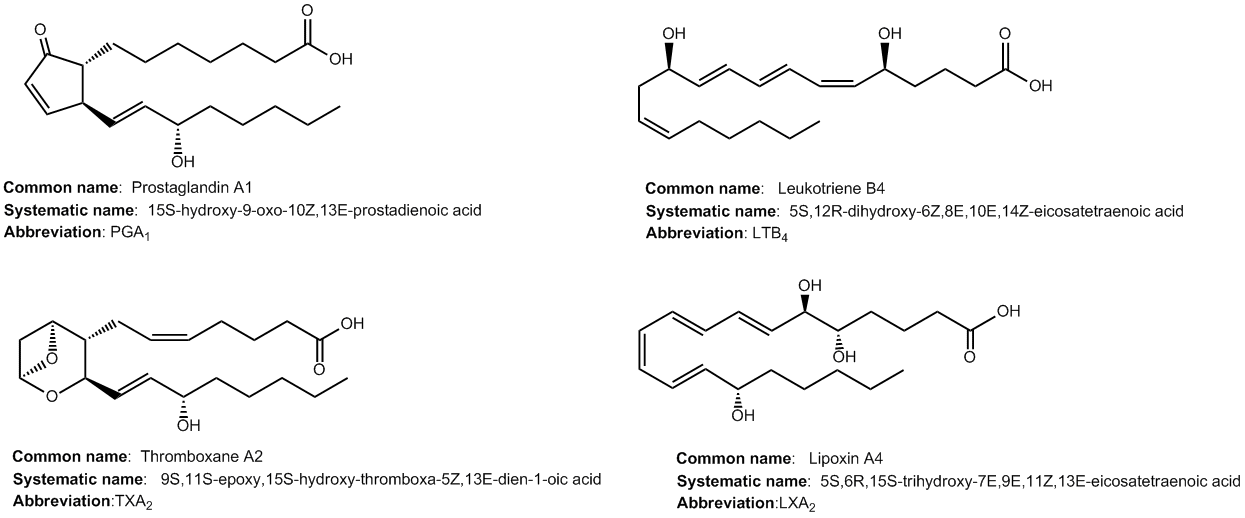
Glycerolipids [GL]
Glycerolipids are composed mainly of mono-, di- and tri-substituted glycerols, the most well-known being the fatty acid esters of glycerol (triacylglycerols), also known as triglycerides. These comprise the bulk of storage fat in mammalian tissues. Macrocyclic ether lipids also occur as glycerolipids in the membranes of archaebacteria.
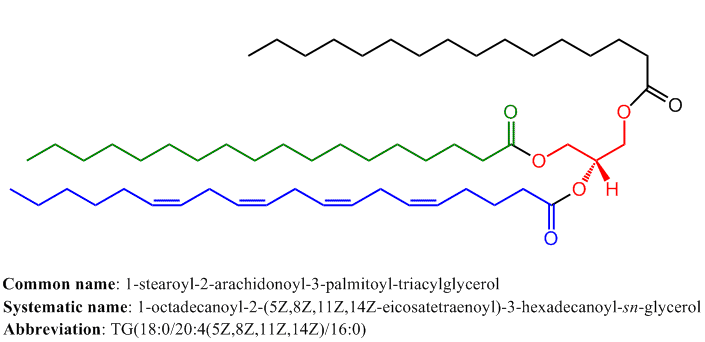
Glyceroglycolipids represent additional subclasses which are characterized by the presence of one or more sugar residues attached to glycerol via a glycosidic linkage. Examples of structures in this category are the digalactosyldiacylglycerols found in plant membranes and seminolipid from mammalian spermatazoa.
Glycerophospholipids [GP]
Glycerophospholipids, also referred to as phospholipids, are ubiquitous in nature and are key components of the lipid bilayer of cells, as well as being involved in metabolism and signaling. Glycerophospholipids may be subdivided into distinct classes, based on the nature of the polar headgroup at the sn-3 position of the glycerol backbone in eukaryotes and eubacteria or the sn-1 position in the case of archaebacteria. Examples of glycerophospholipids found in biological membranes are phosphatidylcholine (also known as PC or lecithin), phosphatidylethanolamine (PE),phosphatidylinositol (PI) and phosphatidylserine (PS). In the case of the glycerophosphoglycerols and glycerophosphoglycerophosphates, a second glycerol unit constitutes part of the head group, whereas for the glycerophosphoglycerophosphoglycerols (cardiolipins), a third glycerol unit is typically acylated at the sn-1' and sn-2' positions to create a pseudosymmetrical molecule. Each head group class is further differentiated on the basis of the sn-1 and sn-2 substituents on the glycerol backbone. Although the glycerol backbone is symmetrical, the second carbon becomes a chiral center when the sn-1 and sn-3 carbons have different substituents. A large number of trivial names are associated with phospholipids. In the systematic nomenclature, mono/di-radylglycerophospholipids with different acyl or alkyl substituents are designated by similar conventions for naming of classes (see below) and are grouped according to the common polar moieties (i.e., head groups). Typically, one or two of the glycerol hydroxyl groups are acylated with long-chain fatty acids, but there are also alkyl-linked and 1Z-alkenyl-linked (plasmalogen) glycerophospholipids, as well as dialkylether variants in prokaryotes. The main biosynthetic pathways for the formation of PC and PE were elucidated through the efforts of Eugene P. Kennedy and coworkers in the 1950s and 1960s, and more detailed interconversion pathways to form additional classes of phospholipids were described more recently.

In addition to serving as a primary component of cellular membranes and binding sites for intra- and intercellular proteins, some glycerophospholipids in eukaryotic cells, such as phosphatidylinositols and phosphatidic acids are either precursors of, or are themselves, membrane-derived second messengers.
Sphingolipids [SP]
Sphingolipids are a complex family of compounds that share a common structural feature, a sphingoid base backbone that is synthesized de novo from serine and a long-chain fatty acyl-CoA, then converted into ceramides, phosphosphingolipids, glycosphingolipids, and other species, including protein adducts . A number of organisms also produce sphingoid base analogs that have many of the same features as sphingolipids (such as long-chain alkyl and vicinal amino and hydroxyl groups) but differ in other features. These have been included in this category because some are known to function as inhibitors or antagonists of sphingolipids, and in some organisms, these types of compounds may serve as surrogates for sphingolipids. Sphingolipids can be divided into several major classes: the sphingoid bases and their simple derivatives (such as the 1-phosphate), the sphingoid bases with an amide-linked fatty acid (e.g., ceramides), and more complex sphingolipids with head groups that are attached via phosphodiester linkages (the phosphosphingolipids), via glycosidic bonds (the simple and complex glycosphingolipids such as cerebrosides and gangliosides), and other groups (such as phosphono- and arseno-sphingolipids). The major sphingoid base of mammals is commonly referred to as "sphingosine," because that name was affixed by the first scientist to isolate this compound. Sphingosine is (2S,3R,4E)-2-aminooctadec-4-ene-1,3-diol (it is also called D-erythro-sphingosine and sphing-4-enine). This is only one of many sphingoid bases found in nature, which vary in alkyl chain length and branching, the number and positions of double bonds, the presence of additional hydroxyl groups, and other features. The structural variation has functional significance; for example, sphingoid bases in the dermis have additional hydroxyls at position 4 (phytoceramides) and/or 6 that can interact with neighboring molecules, thereby strengthening the permeability barrier of skin. Sphingoid bases are found in a variety of derivatives, including the 1-phosphates, lysosphingolipids (such as sphingosine 1-phosphocholine as well as sphingosine 1-glycosides), and N-methyl derivatives (N-methyl, N,N-dimethyl, and N,N,N-trimethyl). In addition, a large number of organisms, such as fungi and sponges, produce compounds with structural similarity to sphingoid bases, some of which (such as myriocin and the fumonisins) are potent inhibitors of enzymes of sphingolipid metabolism. Ceramides (N-acyl-sphingoid bases) are a major subclass of sphingoid base derivatives with an amide-linked fatty acid. The fatty acids are typically saturated or monounsaturated with chain lengths from 14 to 26 carbon atoms; the presence of a hydroxyl group on carbon 2 is fairly common. Ceramides sometimes have specialized fatty acids which has a 30 carbon fatty acid with a hydroxyl group on the terminal carbon. Ceramides are generally precursors of more complex sphingolipids. The major phosphosphingolipids of mammals are sphingomyelins (ceramide phosphocholines), whereas insects contain mainly ceramide phosphoethanolamines and fungi have phytoceramidephosphoinositols and mannose-containing head groups.
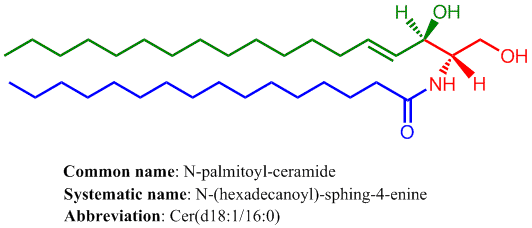
Glycosphingolipids are classified on the basis of carbohydrate composition: 1) neutral glycosphingolipids contain one or more uncharged sugars such as glucose (Glu), galactose (Gal), N-acetylglucosamine (GlcNAc), N-acetylgalactosamine (GalNAc), and fucose (Fuc), which are grouped into families based on the nature of the glyco- substituents as shown in the listing; 2) acidic glycosphingolipids contain ionized functional groups (phosphate or sulfate) attached to neutral sugars or charged sugar residues such as sialic acid (N-acetyl or N-glycoloyl neuraminic acid). The latter are called gangliosides, and the number of sialic acid residues is usually denoted with a subscript letter (i.e., mono-, di- or tri-) plus a number reflecting the subspecies within that category; 3) basic glycosphingolipids; 4) amphoteric glycosphingolipids. For a few glycosphingolipids, historically assigned names as antigens and blood group structures are still in common use (e.g., Lewis x and sialyl Lewis x). Some aquatic organisms contain sphingolipids in which the phosphate is replaced by a phosphono or arsenate group. The other category includes sphingolipids that are covalently attached to proteins; for example, -hydroxyceramides and -glucosylceramides are attached to surface proteins of skin, and inositol-phosphoceramides are used as membrane anchors for some fungal proteins in a manner analogous to the glycosylphosphatidylinositol anchors that are attached to proteins in other eukaryotes.
Sterol lipids [ST]
Sterol lipids, such as cholesterol and its derivatives are an important component of membrane lipids,[8] along with the glycerophospholipids and sphingomyelins. The steroids, which also contain the same fused four-ring core structure, have different biological roles as hormones and signaling molecules. The C18 steroids include the estrogen family whereas the C19 steroids comprise the androgens such as testosterone and androsterone. The C21 subclass includes the progestogens as well as the glucocorticoids and mineralocorticoids.
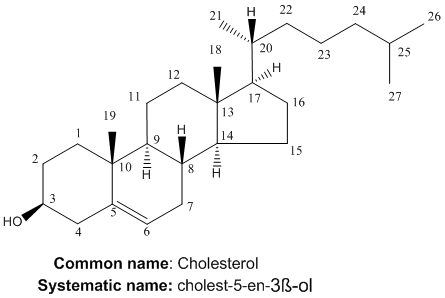
The secosteroids, comprising various forms of vitamin D, are characterized by cleavage of the B ring of the core structure. Other examples of sterols are the bile acids and their conjugates,[9] which in mammals are oxidized derivatives of cholesterol and are synthesized in the liver.
Prenol Lipids [PR]
Prenol lipids are synthesized from the 5-carbon precursors isopentenyl diphosphate and dimethylallyl diphosphate that are produced mainly via the mevalonic acid (MVA) pathway.[10] The simple isoprenoids (linear alcohols, diphosphates, etc.) are formed by the successive addition of C5 units, and are classified according to the number of these terpene units. Structures containing greater than 40 carbons are known as polyterpenes.

Carotenoids are important simple isoprenoids that function as anti-oxidants and as precursors of vitamin A. Another biologically important class of molecules is exemplified by the quinones and hydroquinones, which contain an isoprenoid tail attached to a quinonoid core of non-isoprenoid origin. Vitamin E and vitamin K, as well as the ubiquinones, are examples of this class. Bacteria synthesize polyprenols (called bactoprenols) in which the terminal isoprenoid unit attached to oxygen remains unsaturated, whereas in mammalian polyprenols (dolichols) the terminal isoprenoid is reduced.
Saccharolipids [SL]
Saccharolipids describe compounds in which fatty acids are linked directly to a sugar backbone, forming structures that are compatible with membrane bilayers. In the saccharolipids, a sugar substitutes for the glycerol backbone that is present in glycerolipids and glycerophospholipids. The most familiar saccharolipids are the acylated glucosamine precursors of the Lipid A component of the lipopolysaccharides in Gram-negative bacteria.
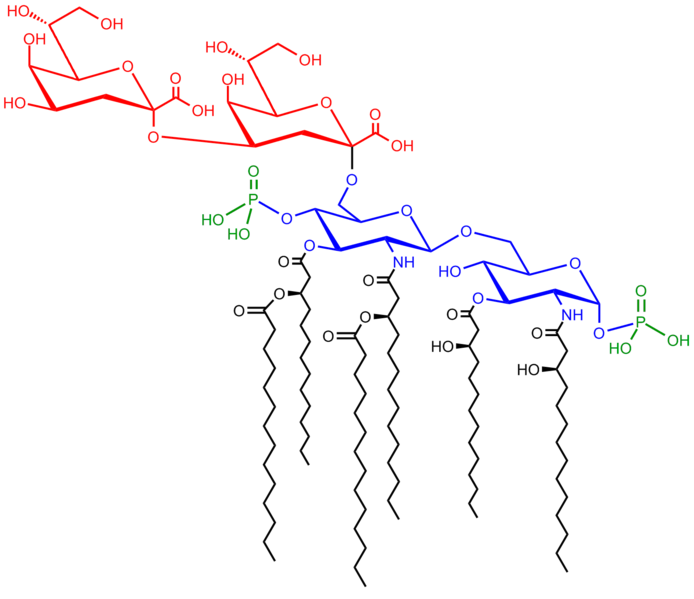
Structure of Kdo2-Lipid A. Glucosamine residues in blue, Kdo residues in red,
acyl chains in black and phosphate groups in green
Typical lipid A molecules are disaccharides of glucosamine, which are derivatized with as many as seven fatty-acyl chains. The minimal lipopolysaccharide required for growth in E. coli is Kdo2-Lipid A, a hexa-acylated disaccharide of glucosamine that is glycosylated with two 3-deoxy-D-manno-octulosonic acid (Kdo) residues.
Polyketides [PK]
Polyketides are synthesized by polymerization of acetyl and propionyl subunits by classic enzymes as well as iterative and multimodular enzymes that share mechanistic features with the fatty acid synthases. They comprise a very large number of secondary metabolites and natural products from animal, plant, bacterial, fungal and marine sources, and have great structural diversity. Many polyketides are cyclic molecules whose backbones are often further modified by glycosylation, methylation, hydroxylation, oxidation, and/or other processes. Many commonly used anti-microbial, anti-parasitic, and anti-cancer agents are polyketides or polyketide derivatives, such as erythromycins, tetracylines, avermectins, and antitumor epothilones.
